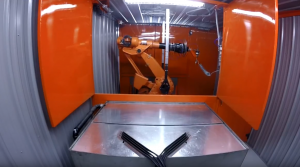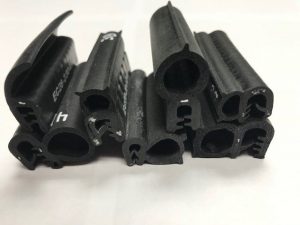Learn how to fasten industrial rubber products from Elasto Proxy. We serve manufacturers and offer finished products that arrive ready to install, saving you time and money during assembly.
Industrial rubber products need to stay in place to provide superior sealing and insulation. A gasket that loosens from a door frame or a headliner that sags from a cabin ceiling isn’t just unsightly. Problems like this prevent rubber products from working properly.
Force, Fasteners, and Adhesives
There are three main ways to attach the industrial rubber products that Elasto Proxy supplies.
- Force presses into position a product that then stays in place because of its own features. For example, edge trim is pressed into place over a flange and then stays in place because of its size and, optionally, interior gripping tongues.
- Fasteners are hardware devices that mechanically join two or more substrates together. Examples include bolts, screws, clips, and rivets. Fasteners are made of metal or plastic and require tools like screwdrivers or rivet guns.
- Adhesives are sticky substances that hold two or more objects together. They’re supplied as liquids, sprays, or tapes. Adhesives differ by cure time: how long it takes to achieve full strength. They also vary by tack: how quickly an adhesive bond forms.
This article focuses on fasteners and adhesives because some industrial rubber products can be attached with either method. Sometimes, both methods are used. For example, a cab manufacturer can use an adhesive to attach a headliner and then use fasteners to keep it in place.
Metal and Plastic Fasteners
Fasteners for industrial rubber products are usually made of metal or plastic.
Metal Fasteners
Metal fasteners have higher tensile strength: the maximum stress a material can withstand before it breaks. They can also withstand higher temperatures, which supports their use in hot environments like engine bays. Metal is also more durable than plastic for wear-resistance and longevity.
Plastic Fasteners
Plastic fasteners have lower tensile strength and can’t match the high-temperature resistance or durability of metal ones. However, plastic fasteners are less expensive and lighter weight. This supports their use in environments like heavy equipment interiors.
Application-Specific Considerations
Just as there isn’t one type of “black rubber”, there isn’t one type of metal or one type of plastic. If you’re planning to use fasteners, consider whether you need a specialized material like glass-filled nylon. The glass fibers improve strength, stiffness, and durability.
There are other considerations as well. For example, if you need to install a rubber product in a saltwater environment, galvanic corrosion will occur if two different types of metal, such as a steel screw and an aluminum panel, come into direct contact. Using a zinc-coated fastener can help.
Fastener Advantages and Disadvantages
Advantages of Fasteners
Fasteners offer the following advantages.
- Versatility: There are many different types of metal and plastic fasteners, and they come in a choice of shapes, sizes, styles, and materials.
- Accessibility: Fasteners are easy to source and are generally inexpensive.
- Assembly: Fasteners support repositioning. For example, an installer can pause assembly to better align a rubber gasket with a door frame.
- Disassembly: Installers can remove fasteners if an installation is incorrect, or a rubber product requires repair or replacement.
- Speed: Fasteners require less preparation and setup time than some adhesives. Fasteners don’t need primers and you don’t have to wait for them to achieve full strength.
Disadvantages of Fasteners
- Failure: Metal fasteners may corrode, and plastic fasteners can break.
- Loosening: Fasteners can loosen over time because of vibrations, such those that travel from engines to cabins, and because of thermal expansion and contraction.
- Stress: Fasteners don’t distribute stresses; they concentrate them. This makes fasteners susceptible to shear stresses that occur when one surface slides against another.
- Appearance: Fastener heads can be unsightly. Raised fastener heads can also suggest poor workmanship.
- Skill: Engineers need to know which type of fastener to select, and assemblers need to apply the proper amount of torque. Also, fasteners can be difficult to install on curved surfaces.
- Weight: Fasteners, even plastic ones, add weight to assemblies.
Liquid, Spray, and Tape Adhesives
Adhesives are sticky substances that are brushed or rolled on, sprayed on, or taped on. Most require surface preparation with cleaning and light sanding. Some adhesives need a primer, a coating that’s applied first so the adhesive will form a better bond.
There’s a lot to consider with adhesives, but let’s start with some basic considerations.
Basic Considerations
- Gasket Material: What is the compound that your rubber product made of?
- Substrate Material: What is the material to which you need to attach the rubber product?
- Budget (cost): How much can you spend for the liquid, spray, or tape adhesive?
- Temperature: What is your application’s temperature range?
Depending on the application environment, you may also need to consider factors such as humidity levels or exposure to sunlight. MTAP, an acronym that Elasto Proxy uses for gasket material selection, can also guide you during adhesive selection.
With these basic considerations in mind, you can choose an adhesive chemistry.
Adhesive Chemistries
There are three main chemistries for liquid, spray, and tape adhesives.
- Rubber
- Acrylic
- Silicone
The chemistry you select determines cost and performance.
Rubber Adhesives
Rubber-based adhesives stick to EPDM and silicone, metals like aluminum and steel, and plastics like polyethylene (PE) and polypropylene (PE). They are the least expensive type of adhesive, but also the lowest-performing. For example, rubber adhesives won’t withstand sunlight, and exposure to chemicals can cause them to swell, soften, or dissolve. These adhesives also have the most limited range of operating temperatures: 50°F (10°C) to 150°F (65°C).
Acrylic Adhesives
Acrylic-based adhesives stick to most types of rubber and metal but can be difficult to bond to plastics without adequate surface preparation. They are mid-range in cost and can withstand application temperatures between 50°F (-46°F) to 350°F (177° C). They have a lower initial adhesion, or tack, than rubber-based adhesives, but that makes it possible to reposition rubber products after they’re attached to a substrate.
Silicone Adhesives
Silicone-based adhesives work best with silicone rubber products. Some can stick to other materials, but at the expense of holding power. Silicone-based adhesives are the most expensive, but they offer the widest temperature range: -80°F (-62°C) to 450°F (232°C). They can also resist chemicals and sunlight. Because silicone-based adhesives repel moisture and water, they are often used in outdoor applications.
Liquid and Spray Adhesives
Adhesive chemistry alone won’t help you determine which type of adhesive product you need. Liquid and spray adhesives each have their advantages, but both have important drawbacks. That’s part of the reason why tape adhesives are becoming increasingly popular.
Advantages
Liquid and spray adhesives each have specific advantages.
- Liquid adhesives are good for tight spaces and can be applied with low-cost brushes and rollers.
- Spray adhesives can use either handheld applicators or automated equipment, depending on production volumes.
Importantly, both can join industrial rubber products to curved, irregular, or odd-shaped surfaces. With a cabin headliner, for example, there are curved surfaces where the ceiling meets the cabin walls.
Disadvantages
Liquid and spray adhesives can be messy. In addition to surface preparation, they may require time-consuming setups and cleanups. Inside a heavy equipment cab, for example, an installer may need to cover the seats and instrument panel. After the adhesive is applied and the headliner is installed, there may still be adhesive residues to remove because of spills or overspray.
Additional Considerations
Many liquid and spray adhesives contain solvents, and this raises regulatory issues and environmental health and safety concerns. Products that use water instead of solvents are available, but the bonds they form usually aren’t as strong. Water-based adhesives also take longer to dry, which extends assembly times.
Tape Adhesives
The final way to fasten industrial rubber products is with tape adhesives. These products offer important advantages over liquid and spray adhesives, and over fasteners as well.
- Unlike liquid and spray adhesives, tape adhesives don’t require brushes, rollers, or applicators because the adhesive is part of the tape itself. Adhesive tapes aren’t messy, and they don’t require time-consuming setups and cleanups.
- Unlike fasteners, adhesive tapes don’t require tools for installation. They also distribute stress loads across the entire surface and provide smooth, seamless bonds for an attractive appearance.
Importantly, tape adhesives can come attached to a finished rubber product. As you’ll learn, that provides installers with a “peel and stick” solution that speeds assembly.
Types of Adhesive Tapes
There are three main types of adhesive tapes.
- Transfer tapes have a release liner that remains attached to the tape until it’s time to install the rubber product. At that point, an installer peels back the liner and sticks the rubber product to the substrate by applying light pressure. Adhesive tapes are thin and flexible. They also have a low profile because they don’t have a carrier to hold the adhesive.
- Double sided tapes have a carrier or backing. The carrier is made of paper, plastic, foam, or film and has an adhesive on each side. Double sided tapes can use two different adhesives for dissimilar materials. These tapes are available with carriers ranging from thick foams for cushioning to thin films for low-profile installation.
- 3M™ VHB tapes are double-sided foam tapes from 3M™ that use high-performance acrylic adhesives. These very high bond (VHB) tapes conform to various shapes and, in some cases, are strong enough to replace rubber gaskets. 3M™ VHB tapes that do not require a primer can further speed installation. The bonds they form are significantly stronger than rivets.
PSA Tapes vs. HATS Tapes
If you’re considering adhesive tapes, you’ll also need to decide whether you want a product that uses a pressure-sensitive adhesive (PSA) or a heat-activated taping system (HATS).
- PSA tapes are tacky and stick to surfaces when light pressure is applied. They cure quickly but are used mainly for temporary fastening. Sometimes, PSA tapes are used to hold a rubber product in place until an installer can use fasteners. Many of Elasto Proxy’s customers use PSA tapes and fasteners together in this way.
- HATS tapes won’t become tacky until the adhesive is activated by a heat source. They are more expensive than PSA tapes and require up to 24 hours of curing. HATS tapes are superior in terms of adhesive strength, however, and their bonds can withstand moisture. Elasto Proxy uses 3M™ HATS tape because it’s the industry standard for high-performance.
Choose Industrial Rubber Products from Elasto Proxy
Elasto Proxy supplies industrial rubber products arrive ready to install. Consider the time and money you could save by sourcing gaskets, headliners, and other sealing and insulation solutions that come with adhesive tape that an installer just needs to peel back. Contact us to learn more.










